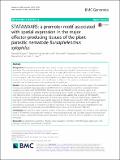Files in this item
STATAWAARS : a promoter motif associated with spatial expression in the major effector-producing tissues of the plant-parasitic nematode Bursaphelenchus xylophilus
Item metadata
| dc.contributor.author | Espada, Margarida | |
| dc.contributor.author | Eves-van den Akker, Sebastian | |
| dc.contributor.author | Maier, Tom | |
| dc.contributor.author | Vijayapalani, Paramasivan | |
| dc.contributor.author | Baum, Thomas | |
| dc.contributor.author | Mota, Manuel | |
| dc.contributor.author | Jones, John T. | |
| dc.date.accessioned | 2018-07-27T10:30:05Z | |
| dc.date.available | 2018-07-27T10:30:05Z | |
| dc.date.issued | 2018-07-27 | |
| dc.identifier | 255089145 | |
| dc.identifier | acd5d7b4-3f6d-4057-818b-720cbc61ea93 | |
| dc.identifier | 85050598566 | |
| dc.identifier | 000440221800001 | |
| dc.identifier.citation | Espada , M , Eves-van den Akker , S , Maier , T , Vijayapalani , P , Baum , T , Mota , M & Jones , J T 2018 , ' STATAWAARS : a promoter motif associated with spatial expression in the major effector-producing tissues of the plant-parasitic nematode Bursaphelenchus xylophilus ' , BMC Genomics , vol. 19 , 553 . https://doi.org/10.1186/s12864-018-4908-2 | en |
| dc.identifier.issn | 1471-2164 | |
| dc.identifier.other | RIS: urn:D6C28EB282EA0196E45F472BC1741D90 | |
| dc.identifier.other | RIS: Espada2018 | |
| dc.identifier.uri | https://hdl.handle.net/10023/15716 | |
| dc.description | This work was funded by National Funds through FCT – Foundation for Science and Technology under the Project UID/AGR/00115/2013. ME was funded by FCT under the PhD grant (SFRH/BD/84541/2012). The James Hutton Institute receives funding from the Rural and Environment Science and Analytical Services Division of the Scottish Government. This work was also supported by Hatch Act and State of Iowa funds. SE-vdA is supported by BBSRC grant BB/M014207/1 and BB/R011311/1. | en |
| dc.description.abstract | Background: Plant-parasitic nematodes cause severe damage to a wide range of crop and forest species worldwide. The migratory endoparasitic nematode, Bursaphelenchus xylophilus, (pinewood nematode) is a quarantine pathogen that infects pine trees and has a hugely detrimental economic impact on the forestry industry. Under certain environmental conditions large areas of infected trees can be destroyed, leading to damage on an ecological scale. The interactions of B. xylophilus with plants are mediated by secreted effector proteins produced in the pharyngeal gland cells. Identification of effectors is important to understand mechanisms of parasitism and to develop new control measures for the pathogens. Results: Using an approach pioneered in cyst nematodes, we have analysed the promoter regions of a small panel of previously validated pharyngeal gland cell effectors from B. xylophilus to identify an associated putative regulatory promoter motif: STATAWAARS. The presence of STATAWAARS in the promoter region of an uncharacterized gene is a predictor that the corresponding gene encodes a putatively secreted protein, consistent with effector function. Furthermore, we are able to experimentally validate that a subset of STATAWAARS-containing genes are specifically expressed in the pharyngeal glands. Finally, we independently validate the association of STATAWAARS with tissue-specific expression by directly sequencing the mRNA of pharyngeal gland cells. We combine a series of criteria, including STATAWAARS predictions and abundance in the gland cell transcriptome, to generate a comprehensive effector repertoire for B. xylophilus. The genes highlighted by this approach include many previously described effectors and a series of novel “pioneer” effectors. Conclusions: We provide a major scientific advance in the area of effector regulation. We identify a novel promoter motif (STATAWAARS) associated with expression in the pharyngeal gland cells. Our data, coupled with those from previous studies, suggest that lineage-specific promoter motifs are a theme of effector regulation in the phylum Nematoda. | |
| dc.format.extent | 1398604 | |
| dc.language.iso | eng | |
| dc.relation.ispartof | BMC Genomics | en |
| dc.subject | Bursaphelenchus xylophilus | en |
| dc.subject | Effectors | en |
| dc.subject | Gene regulation | en |
| dc.subject | Promoter motif | en |
| dc.subject | Pharyngeal gland cells | en |
| dc.subject | Host-pathogen interaction | en |
| dc.subject | Plant-parasitic nematode | en |
| dc.subject | QH301 Biology | en |
| dc.subject | DAS | en |
| dc.subject.lcc | QH301 | en |
| dc.title | STATAWAARS : a promoter motif associated with spatial expression in the major effector-producing tissues of the plant-parasitic nematode Bursaphelenchus xylophilus | en |
| dc.type | Journal article | en |
| dc.contributor.institution | University of St Andrews. Biomedical Sciences Research Complex | en |
| dc.contributor.institution | University of St Andrews. School of Biology | en |
| dc.identifier.doi | 10.1186/s12864-018-4908-2 | |
| dc.description.status | Peer reviewed | en |
This item appears in the following Collection(s)
Items in the St Andrews Research Repository are protected by copyright, with all rights reserved, unless otherwise indicated.

